Concrete Pavement Maintenance: Best Practices for Longevity
Concrete pavement has been a fundamental aspect of infrastructure since its historical inception, offering a durable surface for various transportation and heavy-duty applications. The development of concrete pavements has evolved over the years, incorporating advanced materials and mix design to meet the increasing demands of modern infrastructure. This evolution has led to concrete’s reputation for performance and sustainability in public roads, highways, airport runways, and urban pathways.

Materials and construction methodologies play significant roles in the quality and longevity of concrete pavement. The selection of material mix and design considerations such as thickness, joint spacing, and reinforcement respond to anticipated traffic loads and environmental conditions, ensuring the pavement meets the expected performance criteria. Moreover, advancements in construction methodologies have streamlined the installation process, making it more efficient while maintaining the highest standards of quality.
Concrete pavements have seen continuous innovations, encompassing specialized techniques that enhance their functionality and extend their service life. With industry standards and associations providing guidelines and managing best practices, the economic and ecological impacts of concrete pavements have been optimized for future sustainability. As society turns towards more eco-friendly alternatives, the outlook for concrete pavement remains promising with potential for continued technological advancements.
Key Takeaways
- Concrete pavement is renowned for its durability and long-lasting performance.
- The quality of concrete pavements is significantly influenced by material selection and construction practices.
- Continuous innovation and adherence to industry standards ensure the ecological and economic sustainability of concrete pavements.
Historical Development of Concrete Pavements
Concrete pavements have a storied history, advancing from ancient construction techniques to modern engineering marvels. The use of concrete in pavements is documented as far back as Roman times, with their expertise continuing to influence contemporary methods.
During the 19th century, cement became an integral component of construction, leading to the establishment of the first concrete street in Bellefontaine, Ohio, in 1891, a landmark noted by the American Concrete Pavement Association. This innovation laid the groundwork for future projects involving concrete in streets and highways, setting the stage for widespread adoption of concrete pavements.
In the 20th century, advancements in engineering studies, such as those by H.M. Westergaard in 1926, significantly contributed to the design and durability of concrete pavements. His work influenced the American Concrete Pavement Association (ACPA) and others in the field, placing emphasis on the importance of stress and deflection analyses in pavement design.
Throughout the 20th century, the environment also became a focal point, as the industry sought sustainable practices in concrete production and pavement construction.
- 1891: Installation of the first concrete street in the U.S.
- 1926: H.M. Westergaard’s contributions to pavement thickness design.
- 20th Century: Environmental considerations in pavement construction.
Today, concrete pavements are an essential part of infrastructure, balancing longevity and environmental consciousness, and have been perfected over decades by organizations such as the ACPA to ensure their resilience under heavy traffic and over extended periods.
Materials and Mix Design
The selection of materials and their proportions in the mix design are vital for the construction of durable and efficient concrete pavements. The process involves precise measurement and careful consideration of the cement, aggregates, and admixtures used.
Cement and Aggregate Selection
Cement serves as the binder in concrete pavements, and its quality significantly impacts the pavement’s strength and durability. Portland cement is commonly used, but it can be supplemented with fly ash, a byproduct from coal combustion, which enhances the concrete’s performance and sustainability.
Aggregates comprise the bulk of the concrete mix and include both coarse and fine components. They must be clean, hard, and free from any substances that could affect the concrete’s integrity. The ideal aggregate mix balances the size and shape to minimize voids and achieve a dense, stable pavement structure.
Admixtures and Their Functions
Admixtures are added to the concrete mix to alter its properties according to specific needs. They can improve the workability, set time, and endurance of the concrete pavement. Common admixtures include:
- Water-reducing agents, which enhance strength and workability without altering the water content.
- Set accelerators, used when rapid strength gain is necessary, especially in cooler climates.
- Air-entraining agents, which incorporate tiny air bubbles into the concrete, improving freeze-thaw resistance.
Each admixture serves a distinct purpose and must be measured precisely to avoid compromising the concrete pavement’s quality.
Design Considerations
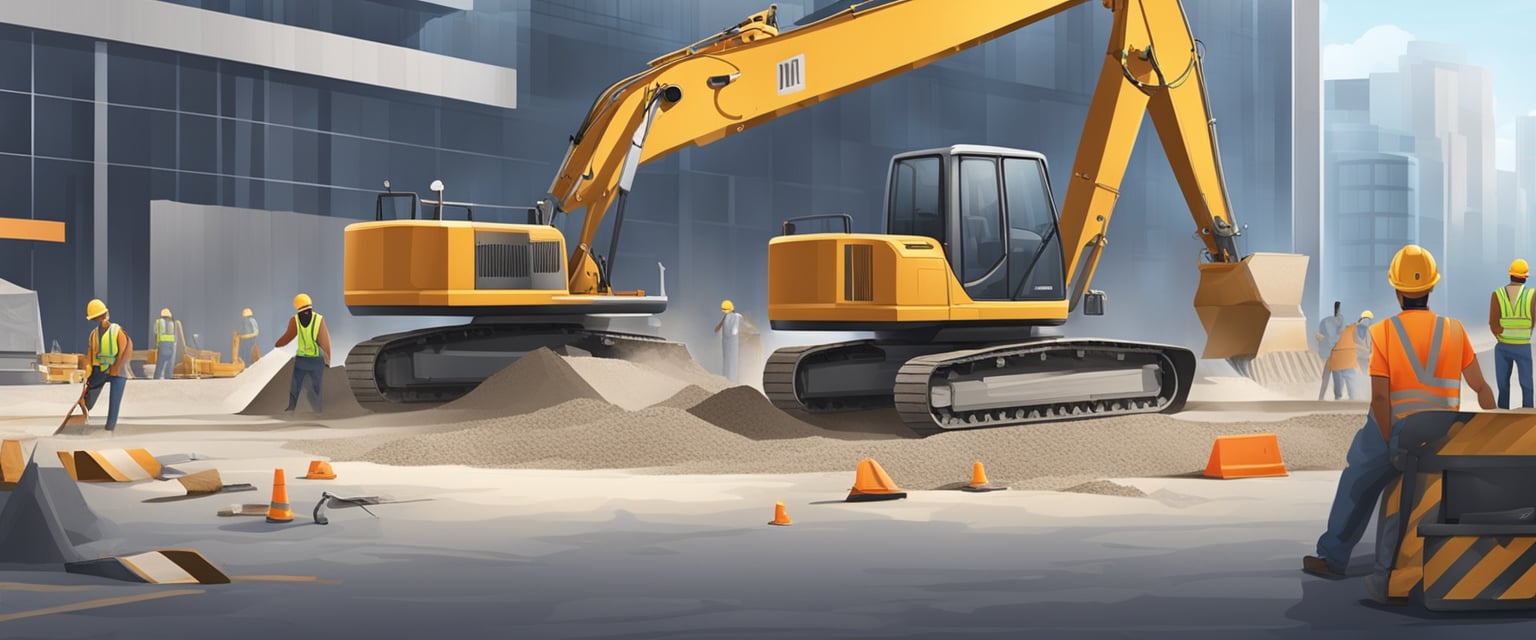
When it comes to designing concrete pavements, engineers must meticulously evaluate critical factors such as pavement thickness and joint structures to ensure longevity and performance. These components are vital to the success of a pavement system and directly impact its durability and maintenance requirements.
Pavement Thickness
Concrete pavement performance is highly dependent on the selection of appropriate pavement thickness. This measure is vital for supporting anticipated traffic loads and environmental conditions. For instance, streets and roadways with heavy vehicle traffic demand a thicker pavement to resist deformation and cracking over time. Accurate thickness design is essential for balancing cost with the pavement’s intended purpose and lifespan.
- Consideration for Thickness Design:
- Traffic Volume and Load
- Subgrade Soil Conditions
- Environmental Factors
Joints and Reinforcement
Joints are necessary in concrete pavements to control cracking and to accommodate pavement expansion and contraction due to temperature fluctuations. Proper design and construction of joints are integral to pavement performance. Two common types include expansion joints and contraction joints. Expansion joints allow for movement without damage, while contraction joints control where cracks should form in the concrete.
- Joint Types:
- Contraction Joints
- Expansion Joints
- Construction Joints
In continuously reinforced concrete pavement (CRCP), steel reinforcement is used to provide tensile strength across the pavement, thus allowing cracks to occur but keeping them tightly closed, reducing the need for joint maintenance. Dowels and tie bars are steel components used in jointed concrete pavement systems—they aid in load transfer and alignment of adjacent slabs.
- Reinforcement Components:
- Dowels: Typically used in transverse contraction joints for load transfer.
- Tie Bars: Employed to keep slabs in place longitudinally, usually at longitudinal joints or edges.
Joints spacing is another critical aspect; correct spacing can reduce stress and prevent random cracking. The combination of proper joint spacing and steel reinforcement leads to enhanced pavement stability and load-bearing capacity.
Construction Methodologies
In the construction of concrete pavements, precision in methodology is crucial. The process begins with the careful preparation of the subgrade, followed by the selection of paving techniques, which include slipform paving and fixed-form paving. Each step requires attention to detail to ensure a durable and reliable pavement structure.
Subgrade Preparation
A strong and stable subgrade is fundamental for the longevity of concrete pavement. It involves thorough site assessment and soil stabilization to create a solid base for the pavement. The base material needs to be well-compacted and graded to precise specifications to support construction traffic and the pavement above. Measures should be taken to ensure the subgrade is not overly moist, preventing soil compaction. The subgrade must offer uniform support to avoid future stresses in the pavement.
Slipform Paving
Slipform paving is a highly efficient method for laying continuous concrete pavement. This technique eliminates the need for fixed forms, instead using a mobile paver that moves along the base material, extruding the concrete into the required shape as it progresses. Key advantages include:
- Faster installation times
- Reduced reliance on labor
- Ability to pave large areas seamlessly
For effective slipform paving, maintaining the correct concrete consistency is paramount, as is keeping a continuous supply of concrete to avoid joints and cracks.
Fixed-Form Paving
In contrast to slipform paving, fixed-form paving utilizes stationary molds—usually metal forms—to shape and support the concrete until it cures. It is particularly suitable for:
- Smaller or irregular areas
- Areas with limited space that may not accommodate slipform machinery
During fixed-form paving, diligent monitoring of concrete temperature and correct curing techniques are required to ensure structural integrity. Forms must be level and firmly secured to prevent dislocation by construction traffic or the weight of the concrete.
By adhering to these construction methodologies, one ensures the final pavement structure is built to meet expected life span and performance criteria.
Pavement Performance and Sustainability
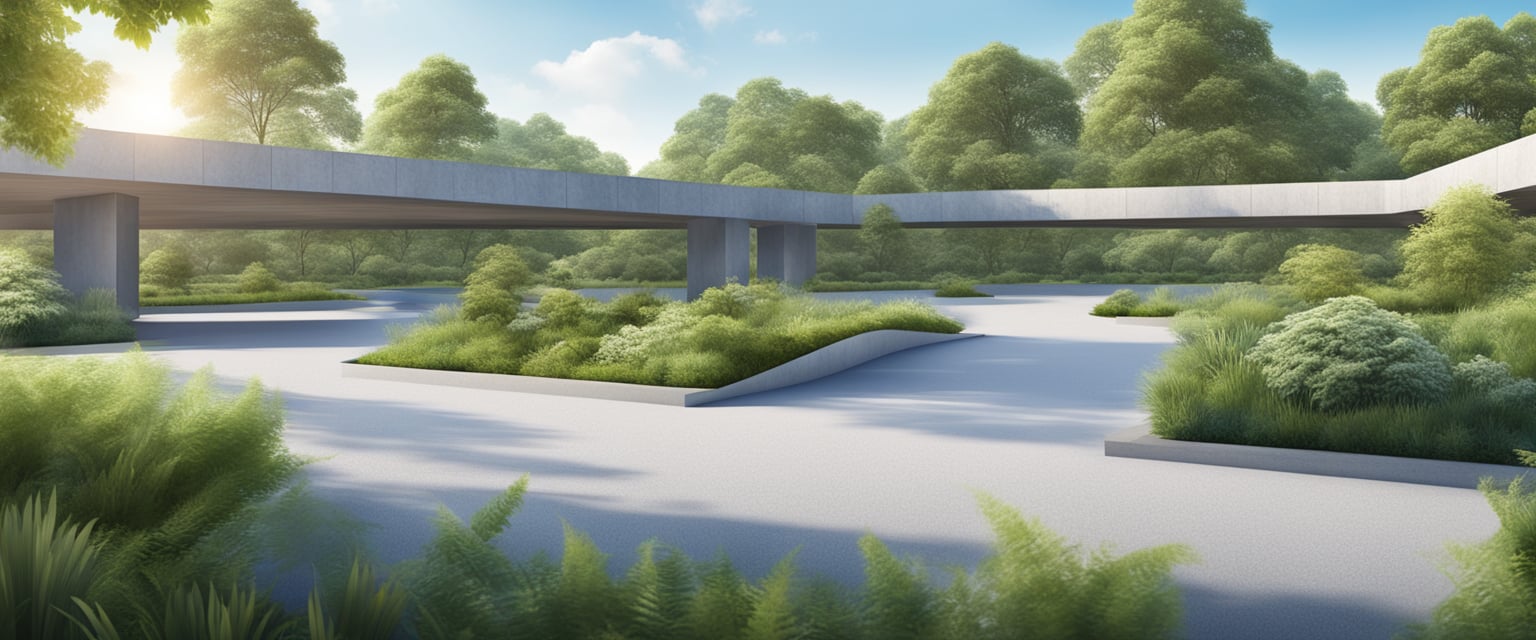
Concrete pavements are integral to modern infrastructure, with performance and sustainability being critical factors in their design and utilization. They are evaluated based on how they stand up to a variety of stresses over time, as well as their overall impact on the environment and climate.
Durability and Longevity
Concrete pavements are noteworthy for their long life span, which can significantly reduce the frequency of repairs and reconstruction. They exhibit high levels of durability against heavy traffic loads and severe weather conditions. The longevity of concrete pavements translates to long-term economic benefits, as it means lower life-cycle costs associated with maintenance and rehabilitation. The American Concrete Pavement Association outlines the role of concrete pavements in creating sustainable and resilient infrastructures. By optimizing materials and construction techniques, these pavements are engineered to last for decades, with some concrete roads serving well beyond their expected design life.
Sustainability Considerations
When considering sustainability aspects of concrete pavements, it’s essential to evaluate the environmental impact across the entire life cycle, from production of materials to end-of-life recycling. Concrete pavement systems contribute to sustainability goals through their inherent material properties and advanced designs. They exhibit a reflective surface, which reduces the amount of heat absorbed and mitigates urban heat island effects, an important climate consideration. Furthermore, they can be constructed using recycled materials and, in turn, can be recycled at the end of their life span, thereby reducing waste and conserving natural resources. It is noted in a white paper released by the ACPA that inclusion of recycling strategies improves the environmental sustainability of concrete pavements. Efforts to enhance the sustainability of concrete pavement systems are supported by research that emphasizes the importance of lowering emissions during production, as well as promoting practices that extend the pavement’s service life and minimize the impact on the environment.
Pavement Types and Applications
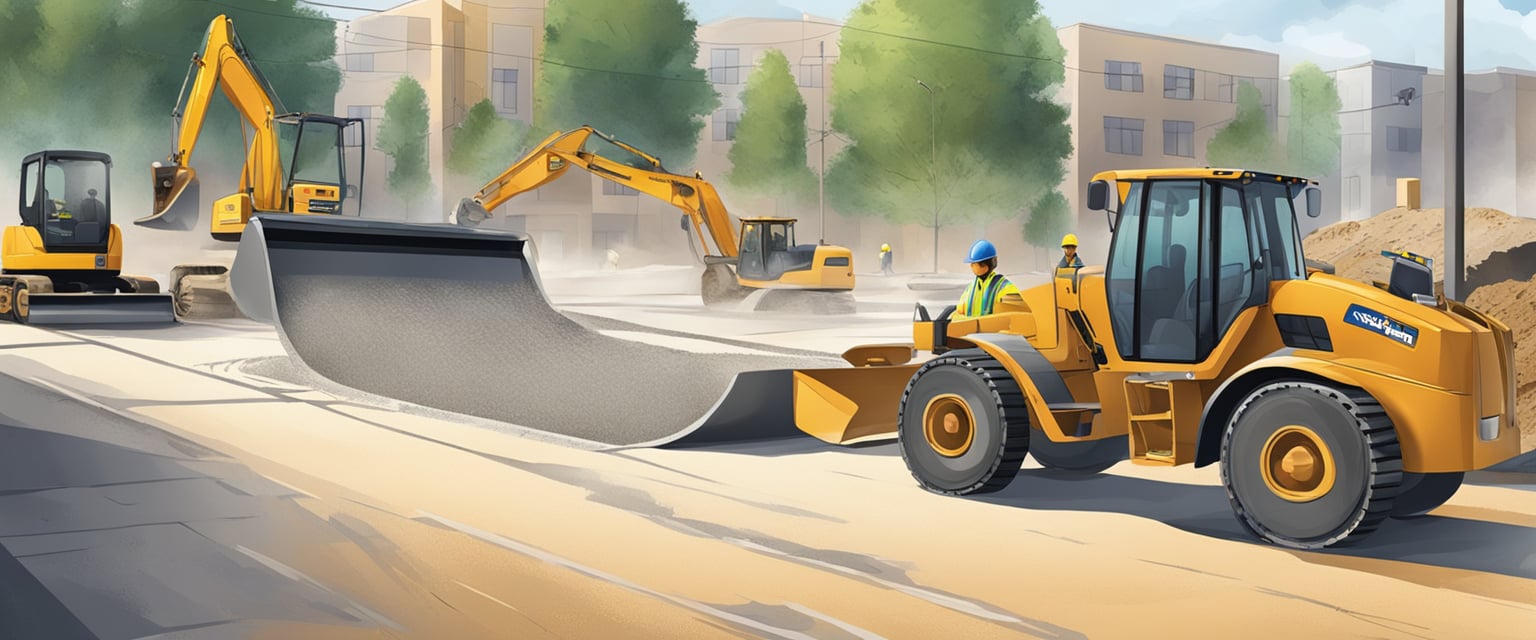
Concrete pavements, distinguished by their rigidity and longevity, are engineered to withstand the demands of both heavy and light traffic. Selecting the appropriate concrete pavement type is crucial for ensuring functionality and durability in applications such as highways, city streets, parking lots, and driveways.
Jointed Plain Concrete Pavement (JPCP)
Jointed Plain Concrete Pavement (JPCP) features contraction joints that control the location of cracks and are typically un-reinforced. They allow the concrete to expand and contract with temperature changes, thus minimizing random cracking. JPCP is commonly used for roads and residential streets, where simplicity and cost-effectiveness are key considerations.
Continuously Reinforced Concrete Pavement (CRCP)
Continuously Reinforced Concrete Pavement (CRCP) does not have contraction joints, as it is reinforced with continuous steel bars or mesh. CRCP is designed to manage crack widths to ensure long-term durability without the need for frequent maintenance. This type of pavement performs well on highways and areas with high traffic volumes.
Roller-Compacted Concrete
Roller-Compacted Concrete (RCC) is a no-slump concrete that is compacted by vibratory rollers. RCC is a cost-effective and durable solution for applications that demand high performance with minimal maintenance, like cargo yards and industrial applications. Its ability to withstand heavy loads makes it a practical choice for parking lots.
Pervious Concrete
Pervious Concrete, known for its ability to allow water to percolate through, is an eco-friendly option that helps manage stormwater runoff. This permeable concrete reduces the need for stormwater infrastructure and is suitable for low-traffic areas such as sidewalks and green spaces in urban environments. It can also be used for residential driveways, offering a sustainable paving solution.
Specialized Techniques and Innovations
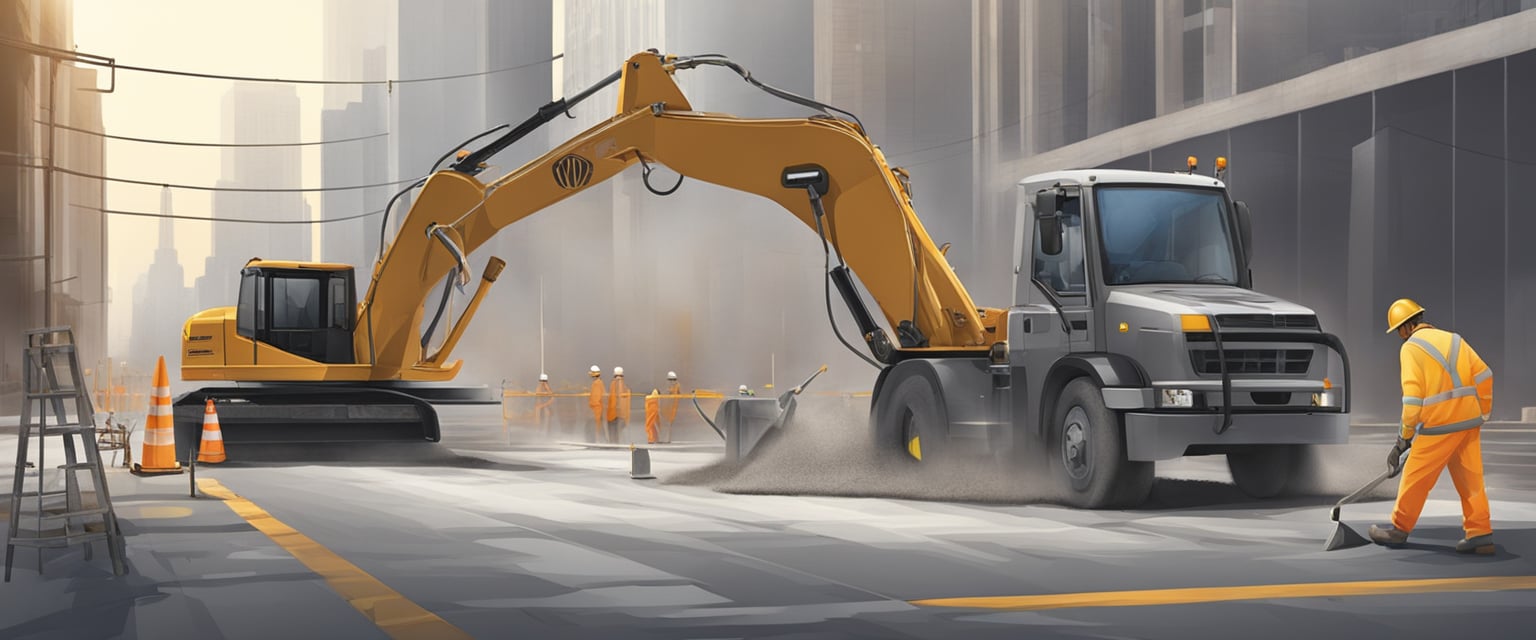
In the realm of concrete pavement, advancements have led to specialized techniques that ensure longevity and safety. These innovations address crucial aspects such as surface textures, methods for distributing loads, and the strategic application of overlays to existing roadways.
Textures for Skid Resistance
Texturing methods are integral to enhancing skid resistance on concrete surfaces, a vital safety feature that reduces vehicle skidding, especially under wet conditions. One prominent technique involves creating fine longitudinal grooves on the pavement surface. These grooves are achieved through specialized equipment that cuts the concrete before it fully hardens, resulting in a finish that maintains traction even during adverse weather.
Load Transfer Mechanisms
For concrete pavement longevity, load transfer mechanisms are essential. They distribute the weight of vehicles across slab joints, mitigating stress and preventing premature cracking. The primary approach for load transfer involves the use of dowels, which are smooth, round, steel bars placed across joints. Dowel bars facilitate the movement of slabs while efficiently transferring loads across the joint, ensuring the pavement remains functional and intact over time.
Concrete Overlays
Concrete overlays are a cost-effective solution for pavement rehabilitation, preserving infrastructure by adding a new layer of concrete over existing roadways. There are several types of overlays, such as the use of embedded steel reinforcement, which imparts additional strength and extends the life of the pavement. Thorough planning and design are necessary to tailor the overlay to the specific conditions and anticipated traffic loads, ensuring seamless integration and durable performance.
Managing Concrete Pavements
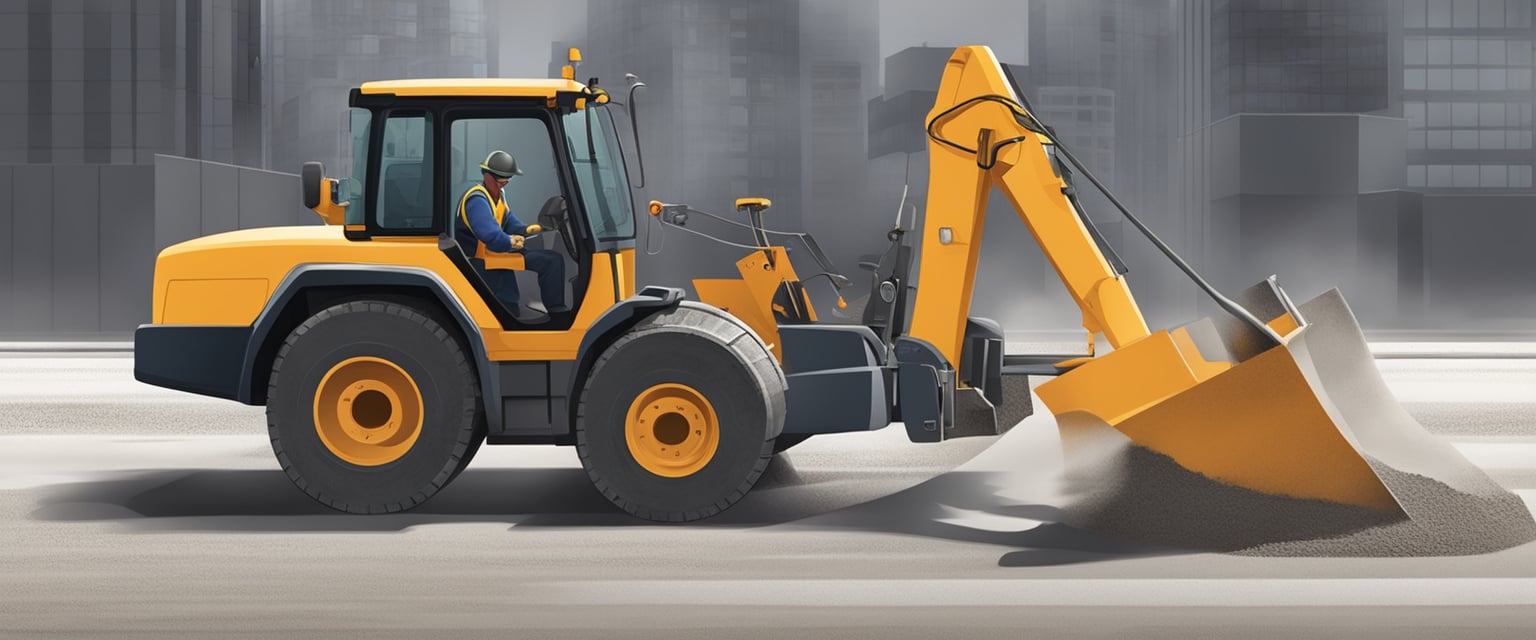
Effective management of concrete pavements involves routine maintenance and timely rehabilitation to ensure longevity, strength, and serviceability. By understanding and implementing strategic maintenance and resurfacing efforts, the stability and durability of the pavement can be preserved.
Maintenance Strategies
Maintenance of concrete pavements requires attention to their stability and resistance to moisture changes. Regularly scheduled inspections can identify issues such as cracks or joint failures that, if left unattended, could impact the pavement’s compressive strength and overall durability. Preventive maintenance techniques include:
- Sealing cracks and joints to prevent water ingress and further deterioration.
- Ensuring proper drainage to minimize the presence and damaging effects of moisture.
Ensuring routine maintenance will mitigate minor issues before they amplify, saving on extensive repair costs.
Rehabilitation and Resurfacing
When pavement surfaces deteriorate significantly, more extensive measures such as rehabilitation and resurfacing are warranted. Rehabilitation may involve extensive repairs to underlying layers to restore structural stability, often necessary when pavements reach the end of their design life or exhibit severe distress. Resurfacing, on the other hand, is a method where a new layer of concrete is applied over the existing pavement. This method is more than a cosmetic enhancement; it can significantly extend the pavement’s service life and improve its load-bearing capacity. Execution of such activities should minimize the impact on traffic, often achieved through the careful design and management of work zones.
Both rehabilitation and resurfacing should be carried out with an understanding of the original concrete’s properties, particularly its compressive strength, and any alterations in moisture content to avoid future instabilities. The selection between these methods depends on the current pavement condition and the expected remaining service life after treatment.
Economic and Ecological Impacts

Concrete pavements represent a significant investment in infrastructure with a direct bearing on the economy and environment. Assessing their cost-efficiency and environmental benefits is pivotal for sustainability and longevity in urban planning.
Cost-Efficiency Analysis
A comprehensive cost-efficiency analysis of concrete pavements must consider both the initial expenses and the long-term economic benefits. The initial production costs are often mitigated by the long life of concrete pavements, which translates to fewer repairs and lower maintenance expenses over time. Studies, such as the assessment conducted in China, suggest that key materials like cement contribute substantially to the initial expenditure. Nevertheless, the economic cost of concrete pavement bricks is shown to be competitive, especially if water-saving features of permeable bricks are factored in during service stages.
Environmental Benefits
The environment benefits from concrete pavements thanks to their sustainability features. Concrete has a high albedo effect, reflecting more sunlight and thereby reducing the urban heat island effect, which can contribute to lower climate change impacts. Additionally, the same pavements absorb CO2 during their lifespan, according to research highlighted by the American Concrete Pavement Association (ACPA). Furthermore, concrete’s durability contributes to fewer resource requirements for replacements, emphasizing its role in a sustainable, resilient future.
Future Outlook
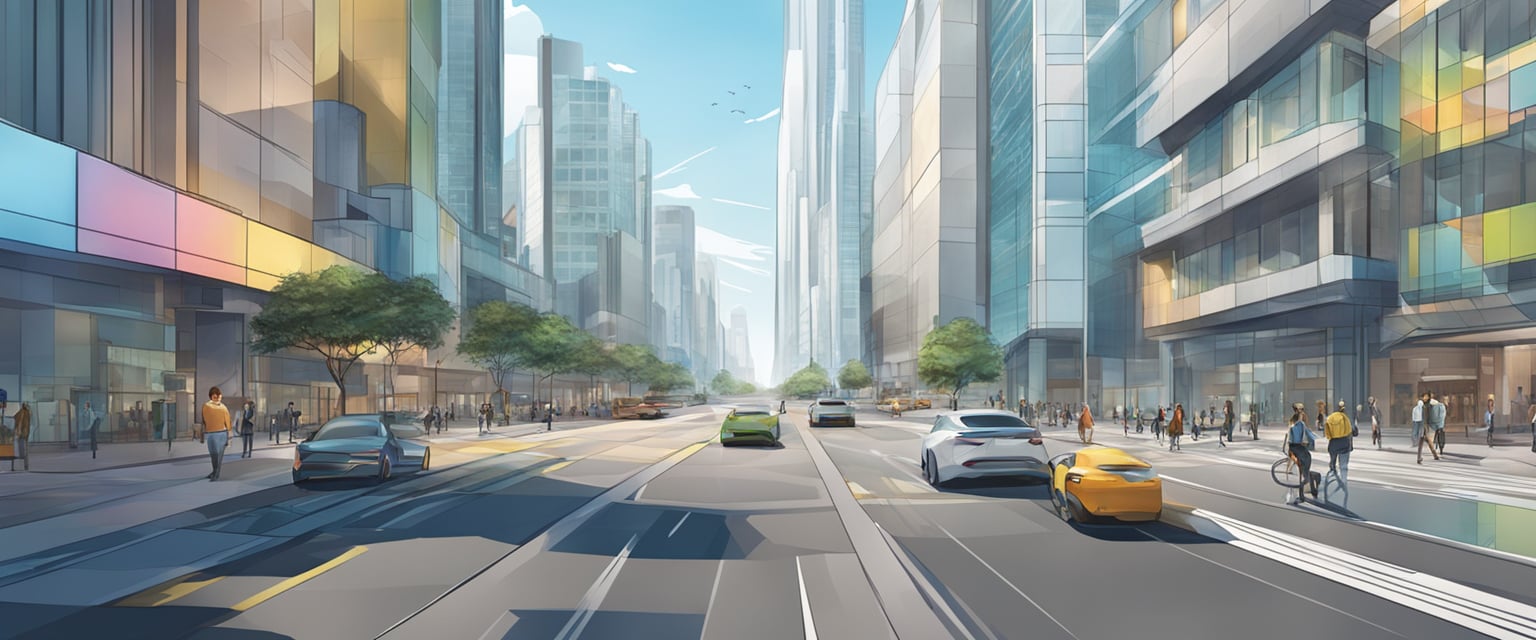
The concrete pavement industry stands at the brink of transformative change with the American Concrete Pavement Association’s (ACPA) mission touching upon a future that embraces integrated paving solutions, research, and policy evolution. Innovations in the field are anticipated to enhance the performance and sustainability of concrete pavements, ensuring they meet the progressive demands of modern infrastructure.
Research and Advancements
Constant research in the field of concrete technology is paving the way for new advancements with a focus on integrated paving solutions. The American Concrete Pavement Association (ACPA) has unveiled VISION2040, a document that envisions the future of concrete paving, reflecting advances such as self-healing concrete and the utilization of smart materials. One significant projected milestone is the goal to achieve carbon-neutral paving materials by 2050, another ambitious but concrete target set by the industry experts.
- Smart technologies: These include sensors that can monitor the condition of concrete pavements in real-time.
- Eco-friendly materials: Efforts are underway to find alternative materials that can reduce concrete’s carbon footprint.
- Durability improvements: Research is focused on increasing the longevity of pavement, thereby reducing the need for frequent repairs.
Policy and Regulation Changes
Policies and regulatory frameworks are crucial in shaping the practical application of research in concrete pavements. The ACPA advocates for policy decisions that will potentially expedite the adoption of innovative concrete solutions. The push for sustainable and resilient infrastructure is reflected in the association’s endorsement of changes that encourage the use of environmentally beneficial practices. These include:
- Legislation that supports green construction and sustainable materials.
- Regulatory guidance that aligns with the mission to lower the industry’s carbon emissions in accordance with international environmental goals.
The regulatory landscape is expected to adapt in response to significant industry research findings, shaping a future where concrete pavement technology is efficient, sustainable, and reliable.
Industry Standards and Associations
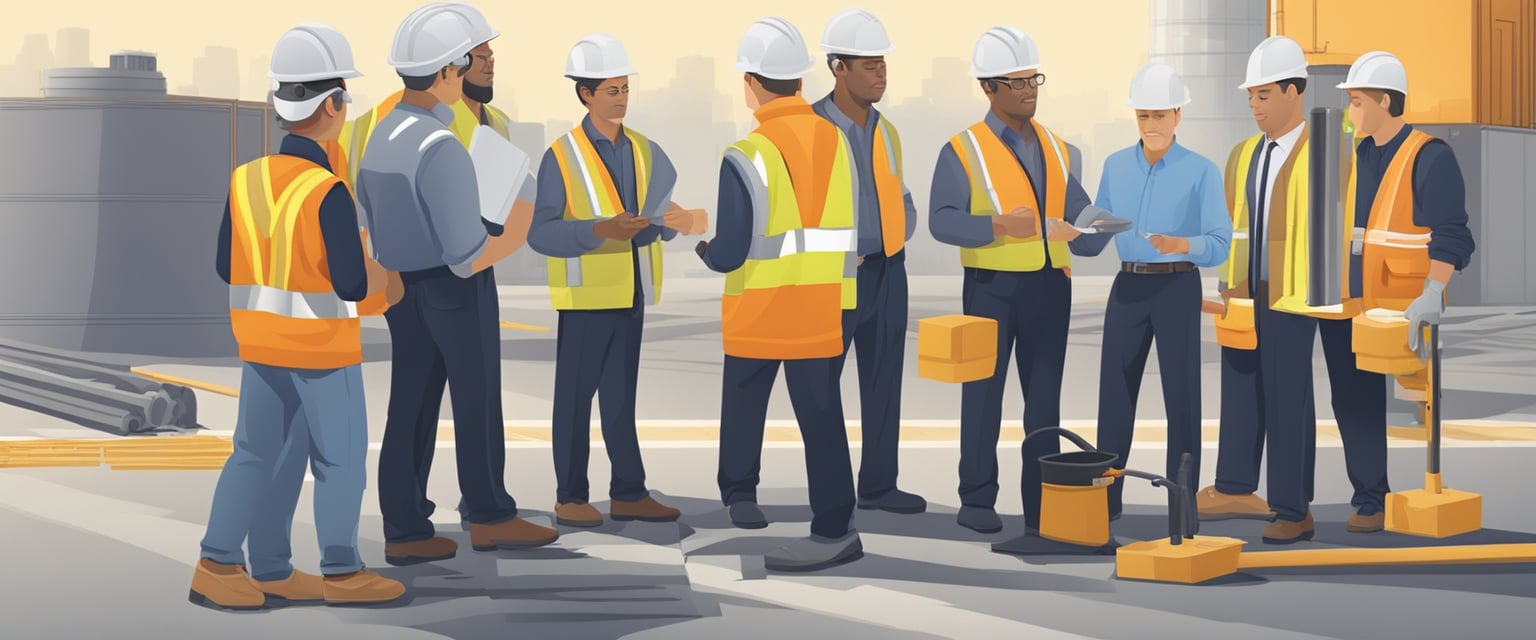
The concrete pavement industry operates within a framework of strict standards to ensure quality, sustainability, and safety in its practices. The American Concrete Pavement Association (ACPA) stands at the forefront, advocating for these standards and providing resources and educational materials to its members.
Key entities that influence industry standards include:
- ACPA: Serves as the voice for concrete pavement industry, guiding research and promoting concrete solutions that meet the criteria for sustainability and robust infrastructure.
- American Concrete Institute (ACI): An authority providing consensus-based standards and technical resources that define the best use of concrete in various construction contexts.
- Department of Transportation (DOT): Sets national regulations and specifications for pavement construction to ensure infrastructure meets public safety and service requirements.
The collaboration among these entities fosters advancements in concrete pavement technologies and practices. They work synergistically to establish widely accepted industry standards that dictate the design, construction, and maintenance of resilient concrete pavements.
Specifically, ACPA provides tools such as StreetPave, an advanced software for concrete pavement thickness design. Alongside such tools, the distribution of publications like “Design of Concrete Pavement for Streets” aides city planners and engineers in applying consistent and cutting-edge methods to urban infrastructure projects.
Entity
Role
ACPA
Industry advocate and research leader
ACI
Standards development and education
DOT
Regulatory body for transportation infrastructure
These standards ensure the industry delivers long-lasting and low-maintenance pavement solutions, which are essential in today’s urban and environmental planning.
Frequently Asked Questions
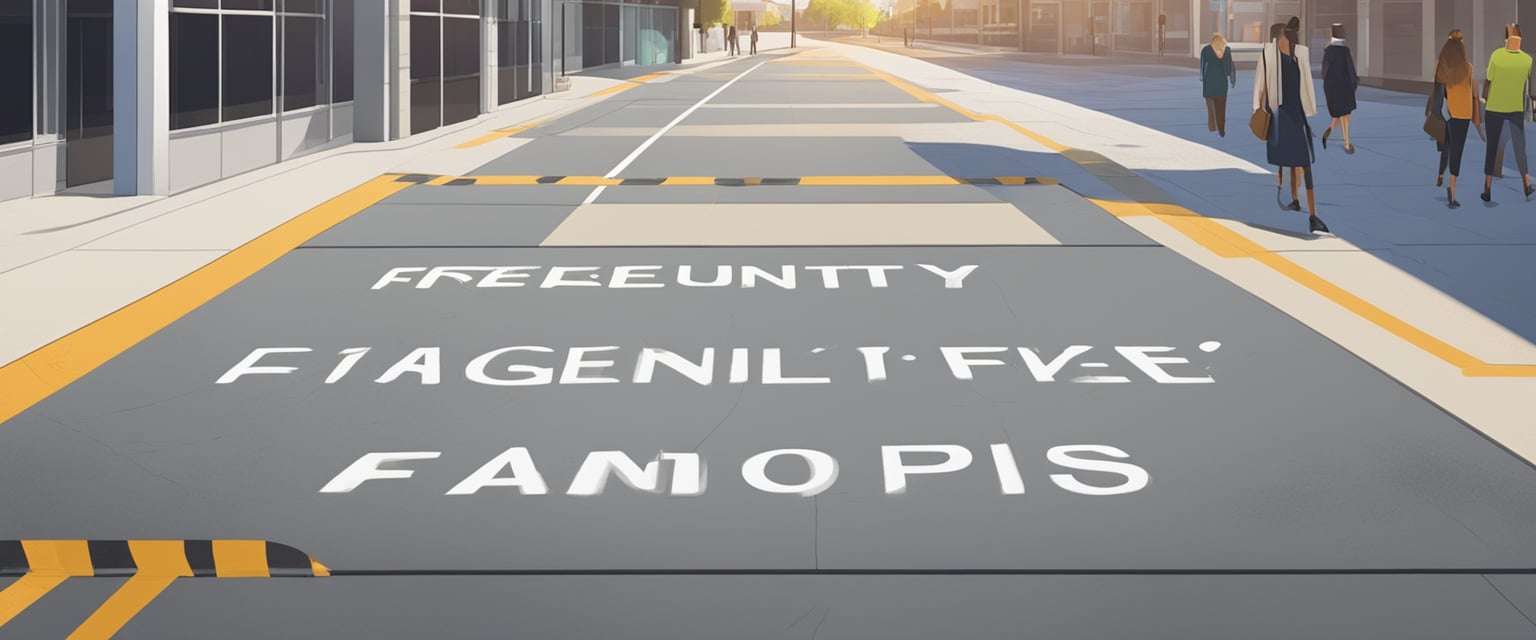
This section addresses common questions about concrete pavements, covering design, durability, textural finishes, maintenance, and specialized uses.
What are the different design methodologies for concrete pavements?
There are multiple design methodologies for concrete pavements, including empirical designs based on accumulated experience and analytical designs that consider material properties and loading scenarios. The American Concrete Pavement Association offers resources on various design methods.
How do concrete pavements compare with asphalt pavements in terms of durability and maintenance?
Concrete pavements generally have a longer lifespan and require less maintenance than asphalt pavements. They are less susceptible to damage from heavy loads and extreme temperatures. Information on specific maintenance practices can be found through resources like CEMEX’s Paving FAQ.
What are the various textural finishes that can be applied to concrete pavements, and what are their benefits?
Textural finishes for concrete pavements, such as brooming, stamping, and adding aggregates, can improve skid resistance and aesthetic appeal. Each finish has different benefits, such as increased safety and enhanced visual integration with the surrounding environment.
What materials and techniques are involved in the repair and maintenance of concrete pavements?
Repair and maintenance of concrete pavements may involve the use of patching materials, sealants, and resurfacing techniques. Properly executed, these interventions can extend the pavement’s service life and improve its performance.
What are the advantages of using concrete pavement blocks in surface construction?
Concrete pavement blocks, also known as interlocking pavers, offer advantages like ease of installation, immediate usability, and high durability. They can also be replaced individually if damaged, which can reduce overall maintenance costs.
How is concrete specifically formulated or prepared for use in paving applications?
For paving applications, concrete is formulated with specific aggregates, water-cement ratios, and admixtures to attain the desired strength, durability, and finish. The mixture is carefully designed to ensure performance under traffic loads and environmental conditions.



